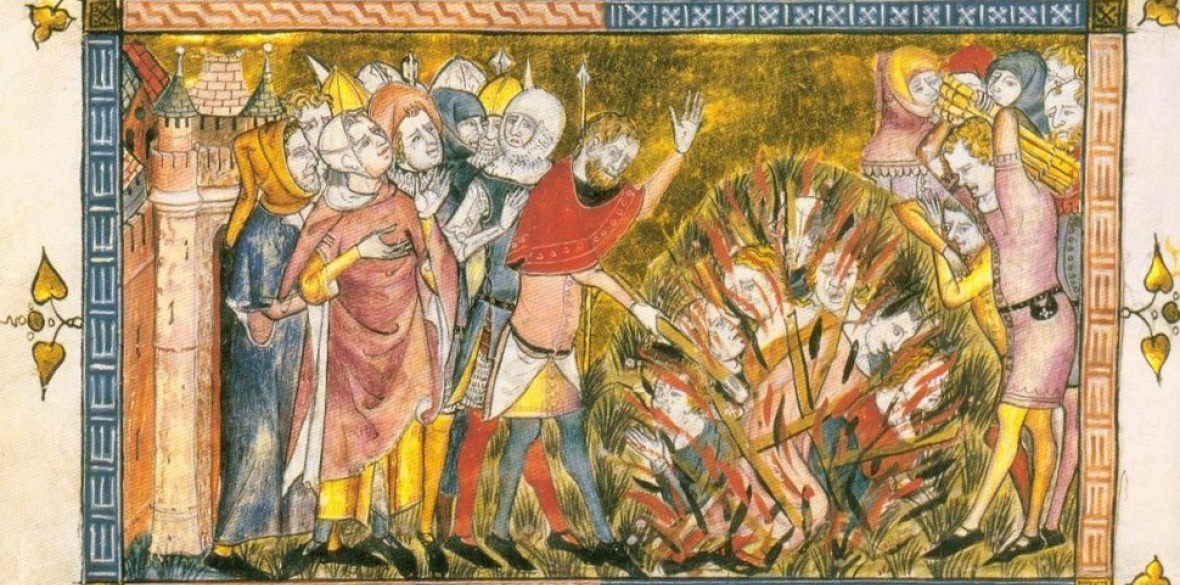This is the last article you can read this month
You can read more article this month
You can read more articles this month
Sorry your limit is up for this month
Reset on:
Please help support the Morning Star by subscribing here
TODAY, anti-semitism is typically understood as the belief that Jews are an inferior race. This form of anti-Jewish discrimination developed in the 18th and 19th centuries in influential strands of European nationalism. Here, Jews were not seen to share the same culture, language, religion, and history of a given nation. Jews could then be used as a convenient target of blame for a nation’s economic, social and political problems. Cliches about Jews were explained in pseudo-scientific terms as inherited racial behaviour.
Modern anti-semitism was also built on centuries of anti-Jewish discrimination and persecution that predated the rise of capitalism and modern nationalism.
Tracing their ancestry back through the Iron Age kingdoms of Judah and Israel, Jews as a recognisable group in the ancient world developed under various empires (eg, Persian, Hellenistic, Roman). Before the emergence of Christianity, Jews faced discrimination, expulsion and persecution. But this was not unusual for minority groups, religions or smaller territories.
Nevertheless, there were significant moments where persecutions singled out specific practices associated with Jews and Judaism. The Maccabean revolt (167-160 BCE) against the Seleucid empire involved the Seleucid ruler Antiochus IV outlawing what were seen as prominent Jewish practices (eg, Sabbath rest, circumcision, dietary laws) and replacing them with practices designed to provoke Jews (eg, sacrificing pigs, desecrating the Jewish Temple), while executing those who disobeyed.
Jews were seen as having stereotypical characteristics by some elite Roman writers, including accusations of misanthropy towards outsiders and refusing to eat with non-Jews. In reality, there was a range of attitudes towards social interactions between Jews and non-Jews. However, ancient stereotypes would persist for centuries and feed into hostility towards Jews.
The emergence of Christianity in the first century was a turning point. The origins of Christianity are not straightforwardly non-Jewish or anti-Jewish. No historian today doubts that the historical figure of Jesus was born a Jew and, for the rest of his life, saw himself and was seen by others as Jewish. He did not intend to start a new religion. The first followers of Jesus were Jewish, as were most in the early years after Jesus’s death. It is even possible that most (even all) of the contents of the New Testament were written by Jews.
However, the movement that became known as Christianity increasingly attracted more non-Jews. Consequently, influential strands of Christianity began identifying the new movement in distinction from Jews and Judaism.
For instance, in Matthew’s Gospel, when Pilate claims to be innocent of Jesus’s blood, it is written that “the people as a whole answered, ‘His blood be on us and on our children!’” This is not found in the other Gospels and did not happen. Those responsible for Matthew’s Gospel may have written this as part of a sectarian or internal Jewish debate. Nevertheless, once this story became part of the Christian canon, then it could be used as part of the myth that Jews were and remained “Christ killers.”
John’s Gospel represents a strand of Christianity from around the end of the first century that framed its understanding of Jesus against “the Jews.” The Jesus of John’s Gospel says of “the Jews” who do not believe that “You are from your father the devil.” John’s Gospel argues that “the Jews” tried to kill Jesus because Jesus claimed to be equal with God. The idea that Jesus is equal with God became a central theological feature of Christianity, often in distinction from Judaism.
One religion claiming superiority over another is hardly news. Some scholars have also tried to downplay the potential anti-Jewish implications in John’s Gospel, while others note that such passages are fictional accounts of Jesus. But with hindsight, the potential for using theological ideas to discriminate against or persecute Jews is clear.
When Christianity became the religion of the Roman empire, established anti-Jewish ideas were part of official ideology. An anti-Jewish template was in place for medieval Europe as Jews established communities northward in Europe. As Christianity came to dominate, Jews were in a dangerous position as a standout minority with the assumption that they were the enemy of the faith.
Comparable comments can be made about the emergence of Islam in the 7th century through the medieval period. There is also a shared theological heritage between Islam and Judaism. There are both positive and hostile statements about Jews in Islamic traditions, with both these tendencies found in the Koran and the subject of heated debate.
The idea of Jews and non-Muslims having second-class status under Muslim rule also developed in some Islamic thought and legal practice. Yet treatment of Jews under Islamic rule or with local Muslim communities depended on context. Ideas about Jews having an inferior legal status were not always implemented or accepted.
Many Jews integrated under Muslim rule in the Middle East and the Iberian peninsula. Islamic and Jewish thought and culture influenced one another. At other times, however, Jews faced persecution and forced conversion.
As with Christianity, then, relations between Jews and Muslims are not inevitably hostile, but the potential for anti-Jewish ideas to be used in Islamic thinking is present and ready to be taken up in the service of Islamic anti-semitism (as, of course, anti-Muslim and anti-Islamic ideas have developed in Christianity and Judaism).
Yet it was in medieval Christian Europe where anti-Jewish sentiments influenced the development of anti-semitism that led up to the Holocaust.
The interpretation of the New Testament claiming Jews bore collective responsibility for the death of Christ became popular, and this now meant that Jews were accused of deicide. The idea of the sinister Jew acting in league with the devil became a prominent slur.
Notorious understandings of Jews developed in this period, such as the “blood libel,” the scare story that Jews engaged in ritualistic drinking of the blood of Christian children. When the Black Death hit Europe in the mid-14th century, Jews were sometimes blamed for its cause, as in another scare story of Jews poisoning wells.
Such scaremongering further justified discrimination against Jews in medieval Europe. This meant that for Jews there were limited options in work and public life. With the church forbidding usury, moneylending became one option for some Jews, which made them a direct target for royal taxation. From this peculiar situation emerged the stereotypical association between Jews, greed and money.
This association with moneylending meant some Jews were liable to be taxed heavily, which in turn contributed to the precariousness of their situation. In England, this process culminated in the expulsion of Jews in 1290 under Edward I. It was not until the mid-17th century, under Oliver Cromwell, that Jews officially returned to England.
Anti-Jewish persecution in England belonged to a pattern of expulsions, persecutions and pogroms throughout medieval Europe. During the First Crusade (1096–99), Jews were slaughtered as crusaders moved eastward, most infamously in parts of what is now modern-day Germany.
Towards the end of the 15th century, coercive conversion of Jews featured alongside expulsions in Portugal and Spain.
As recent scholarship has shown, precursors to modern racial anti-semitism grew out of Christian ideas about the hereditary inferiority of groups like Jews. Visual representations of Jews with grotesque features and physical identity markers also emerged in medieval Europe.
A crucial connection between theological hostility towards Jews and modern anti-semitism came through Martin Luther during the Protestant Reformation. His ominously entitled On the Jews and Their Lies (1543) promoted the burning of synagogues, removal of Jewish houses and abolition of protection for Jews on the highways.
While the influence of Luther’s anti-Jewish polemics is debated, his general influence on Germanic theology was profound and later blended with developing ideas of anti-semitism in the 19th century.
In this tradition, the idea grew that Jesus himself was not only opposed to Jewish theological ideas but was Aryan. This argument (promoted by the British-born Germanophile Houston Stewart Chamberlain) was made on the spurious grounds that Galilee was not ethnically or racially Jewish.
By the time of Hitler, such anti-semitic readings of Christian origins were held by mainstream German (and Nazi) scholars such as Walter Grundmann, KG Kuhn, and Gerhard Kittel.
That Jesus the Jew could be transformed into Jesus the Aryan was, then, the culmination of centuries of theological anti-Judaism that merged into the most dangerous form of anti-semitism in Nazi Germany.
James Crossley is a historian of religion.











